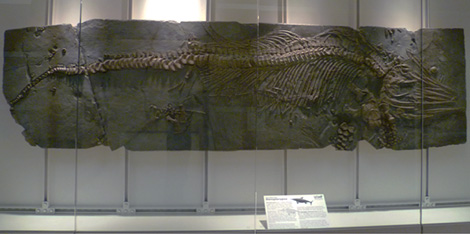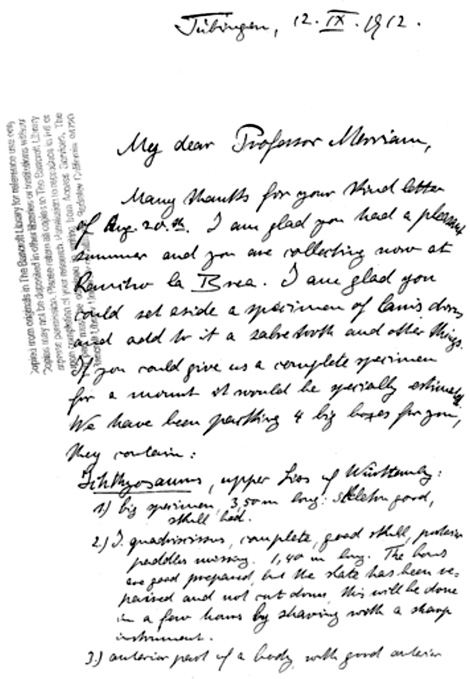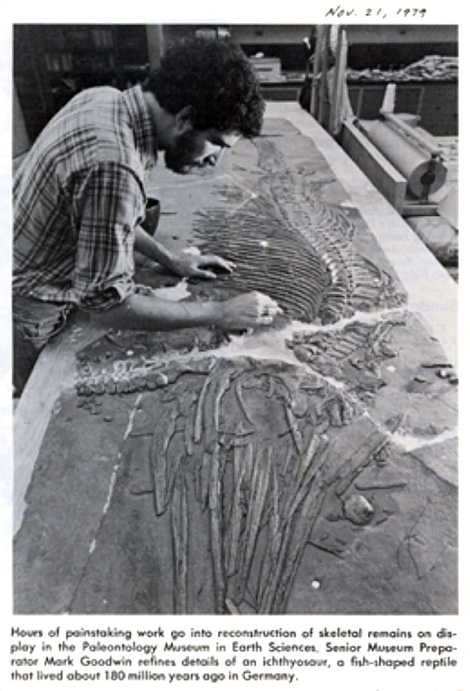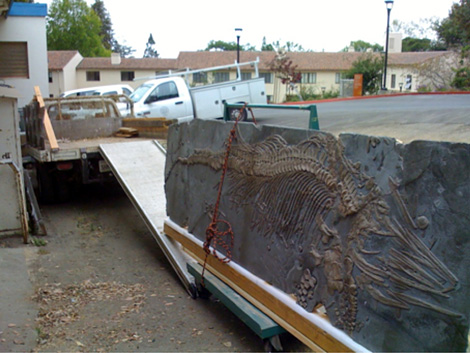How do natural history museums build their collections? The UCMP’s fossil collection is largely a product of decades of field work by past and present researchers. As the State’s fossil repository, the museum also receives a large number of fossil finds from construction sites in California (for example, the Caldecott Tunnel). Another, perhaps less appreciated means of acquiring scientifically valuable specimens, is specimen exchange between institutions — it’s a bit like a holiday gift exchange but without the surprise factor, and the gifts are appreciated by all participants.
If you have visited the Valley Life Sciences Building (VLSB) at Cal recently, you may have seen the skeleton of an ichthyosaur (Stenopterygius, UCMP specimen no. 116080) just down the hall from where the popular T. rex stands. It’s a marine reptile that superficially looks like a big fish or dolphin; it lived during the Jurassic Period, about 180 million years ago.

How did this skeleton, which was found in Germany, end up in the UCMP? You guessed it — specimen exchange! The story actually begins in the early 20th Century, before the museum was established. We know this because of an old letter found in the archival collections at The Bancroft Library on campus.

Written in 1912, this letter from German paleontologist Friedrich von Huene to John C. Merriam (who at the time was the Chair of the Department of Paleontology at Berkeley) describes ichthyosaur specimens that were being packed for shipment to California. Item No. 1 in von Huene’s list (“big specimen, 3.50 m long: skeleton good, skull bad”) is the skeleton on display today. In exchange, von Huene asks for specimens of the dire wolf (Canis dirus) and saber-toothed cat — two iconic carnivores from the Pleistocene “tar pits” of Rancho La Brea in Los Angeles, where their bones had been freshly dug out by Merriam and his crew. This exchange was presumably a win-win deal for the two researchers because Merriam had a strong interest in ichthyosaurs, and von Huene had just toured the United States, visiting museums and possibly collecting fossils at the La Brea tar pits1.
The ichthyosaur made it across the ocean. We don’t know what shape the specimen was in when it arrived in the East Bay after what must have been a treacherous journey for heavy fossils. In the late 1970s, a dozen or so pieces of the skeleton were found (reportedly under the Hearst swimming pool) and given to the Senior Museum Preparator, Mark Goodwin, for repair. After exquisite restoration by Mark (who is now an Assistant Director of UCMP), the ichthyosaur was reborn and put on display in the Earth Sciences Building (now McCone Hall), where it remained until 1995.

That year, the museum moved from the Earth Sciences Building to VLSB, and the ichthyosaur went into storage at the Clark Kerr Campus. But in 2009, UCMP Director Roy Caldwell had the specimen retrieved and displayed in its current location, where it now catches the eye of building visitors and residents alike. Like ancient artifacts in art galleries, many specimens in natural history museums have long and complicated post-discovery histories of their own. And, of course, we would know very little of that history without the documents archived at The Bancroft Library and UCMP.

Finally, what happened to the exchange specimens from Berkeley? We have not found a record of shipment from California, but two mounted skeletons of dire wolf and saber-toothed cat in the Palaeontological Collection at the University of Tübingen (where von Huene worked) may be the gifts from Merriam to his colleague. Can you spot the carnivore skeletons in one of their exhibit halls?
1Unprepared Rancho La Brea fossil material in the Palaeontological Collection of University of Tübingen is associated with von Huene’s field label dated as 1911 (P. Havlik, personal communication, 2013).
Special thanks to Susan Snyder of The Bancroft Library for permission to post von Huene’s letter, Philipe Havlik of the University of Tübingen for information regarding La Brea carnivore specimens in their collection, and Mark Goodwin of the UCMP for information on, and images of, the Stenopterygius specimen on display.